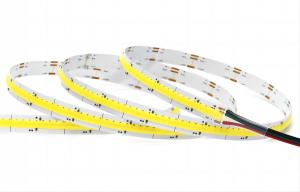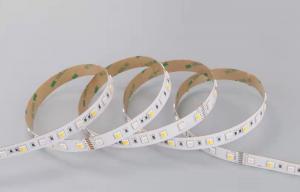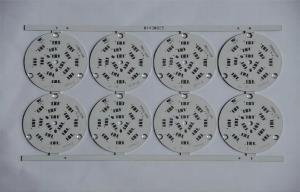Greathome company has mature experience in manufacturing various Flexible LED Strip, COB Light Bar, LED Rigid Strip with single-side/double-side circuit design, and other kinds of Indoor LED lighting, outdoor LED lighting, commercial lighting, industrial lighting and other PCB products.
We support from FPC or PCB design to FPC Assembly and finished LED strip product delivery, and you only need to provide the PCB files or gerber files, and we can help you to manufacture your own designed/ customized PCB products. OEM/ODM is welcome.
If you are looking for a reliable LED lighting PCB or LED Strip product partner in China, please don’t hesitate to contact us.
What is the circuit structure of LED strip?
The circuit structure of conventional LED strip is series and parallel circuit. For example, the LED strip with 12V power supply is composed of three LEDS and a patch resistor in series to form a group of packet circuits. And each LED strip is composed of 10 groups of grouping circuits combined in parallel, The advantages of designing circuit structures in this way are:
1. The use of resistance partial voltage, can effectively ensure that LED work under the specified rated voltage, not because the input voltage exceeds the rated voltage of LED and shorten the service life of LED.
2. Parallel shunt, through the parallel circuit can effectively reduce the impact of rated input current on each group of LED, so that LED can be stable in a current range, so as to greatly improve the service life of LED.
3. Parallel constant voltage, because each group of LED is in parallel structure, therefore, any cutting or extending one group will not affect the normal use of other groups, can effectively save installation cost, not to cause waste.
What is the physical structure of the LED strip?
LED strip, according to the width can be divided into 6mm/8mm/10mm/12mm and other 4 kinds,
According to the size of LED, there are six types: 0603, 0805, 1206, 1210, 5050 and 5060.
So what is the physical structure of each LED strip?
Also take the conventional LED strip as an example to illustrate their physical structure, The spacing of LED strips should be divided according to the specific length of LED strips, Number of leds and cutting positions. Therefore, regardless of the type of LED strip, the layout of its physical structure is calculated according to the following formula:
(The Length of LED strip - width of shearing position X number of shearing)/ Number of LED = LED spacing.
LED spacing /2= Chip resistance and LED spacing
Number of LED /3= Number of chip resistor
The pad width and spacing of LED strip, according to what to determine?
The pad width and spacing of this LED strip is determined according to the LED size specification used.
If it is 0603, the pad width is determined in proportion to 0603.
If the size is 0805, 1206, 1210 and other specifications, the pad width can be 0805 specifications, can also be 1206 specifications, the specific use of how much can be determined according to the power of the LED strip and the power to the resistance.
5050 and 5060 size of LED strip, the pad width must be in line with 1206 specifications, because 5050 and 5060 specifications of LED lamp belt power is relatively large, so there are requirements for the size of the pad and the power of the resistance.
LED strip due to the use of different ways and places, the use of the circuit structure and physical structure is also different.
How to design a reasonable LED strip for customers requires designers to listen to and record customer needs attentively, and also timely correct some unreasonable design requirements of customers. In this way, we can provide customers with the most suitable LED light belt.
The following LED strip as an example, to explain how to tailor LED strip for customers.
How to design the power supply voltage and circuit structure of LED strip?
Conventional LED strip is the use of DC 12V voltage power supply, for some customers with special requirements, how to design the LED strip power supply voltage according to the requirements?
This requires designers to first understand the driving voltage range of each color of LED, and then according to the driving voltage of different colors of LED, to reasonably match the structure of LED strip, and finally achieve the power supply voltage required by customers.
The following is a list of the normal color LED chip driving voltage range:
Red: 1.8 ~ 2.2 V
Yellow: 1.8 ~ 2.3 V
Blue: 3.2 ~ 3.4 V
Green: 3.2 ~ 3.5 V
White: 3.0 ~ 3.4 V
With this voltage range, the designer can design the circuit structure of the LED strip according to the voltage specifications provided by the customer to meet the specific voltage requirements.
The general circuit structure is 3 LEDs + 1 chip resistor series into a group of grouping circuit, and other groups of grouping circuit together and combined to synthesize a group of overall LED strip series and parallel circuit.
According to the current conventional LED chip driving voltage, the power supply voltage of this structure is almost 12V. If the voltage required by the customer is less than 12V, so 2 LEDs + 1 chip resistor structure should be considered. If the voltage required by the customer is very low, the only way is to use the full parallel mode (the disadvantage of this mode is that the current is unstable, easy to burn the LED). Or one LED to match a resistor (try not to use this way, because the resistance takes up too much useless power, is not conducive to energy saving).
How to design the spacing of LED strip?
If the length of LED strip required by the customer has been determined, the number of LED particles has also been determined. Then according to the circuit structure of the LED strip, evenly distribute the LED, and the calculated spacing is the actual spacing of the LED.
For example: the length of LED lamp belt is 450mm, the number of LED is 36, and the circuit structure of 3 LED+1 resistor is adopted, then the spacing of LED is:
(450/(36/3))/3=125mm
The calculation formula is :(total length/number of sets)/3=LED spacing (shear width and shear number included)
How to design the power of LED strip?
If the customer wants to specify the power of the LED strip, the designer will calculate the size and particle number of the LED strip based on the rated power provided by the customer and the nominal power and supply voltage of each LED.
Take the conventional LED strip as an example. If the customer requires 1.8W power per meter of the LED strip, and the LED requires 1210 specification and 12V power supply, the particle count of the LED is calculated as follows:
1. LED strip power per each group: 12V X 20mA=0.24W2,
2. The total number of groups of LED strip: 1.8W/0.24W=7.5 groups/m
3. LED particle number: 7.5 X 3=22.5 Pieces / meter (if the series and parallel circuit structure of 3 LEDs+ 1 chip resistor is used)
7.5 X 2=15 Pieces/meter (if the series and parallel circuit structure of 2 LEDs+ 1 chip resistor is used). Obviously, this number and LED particle number are unreasonable.
How to design the structure of LED strip to meet this power requirement?
The method is as follows:
Reduce voltage: When the voltage of each group of LED strip is reduced to 10V, the power of each group of LED strip is 10 X 20mA=0.2W. However, the total number of LED strip is: (1.8-0.2)/0.2= 8 groups, and the number of LED particles is: 8 X 3= 24 pieces/meter.
(Each meter of LED strip input needs to design a 20 ohm, 1/4W resistance position, using the resistance for voltage distribution, so as to occupy 0.2W power)
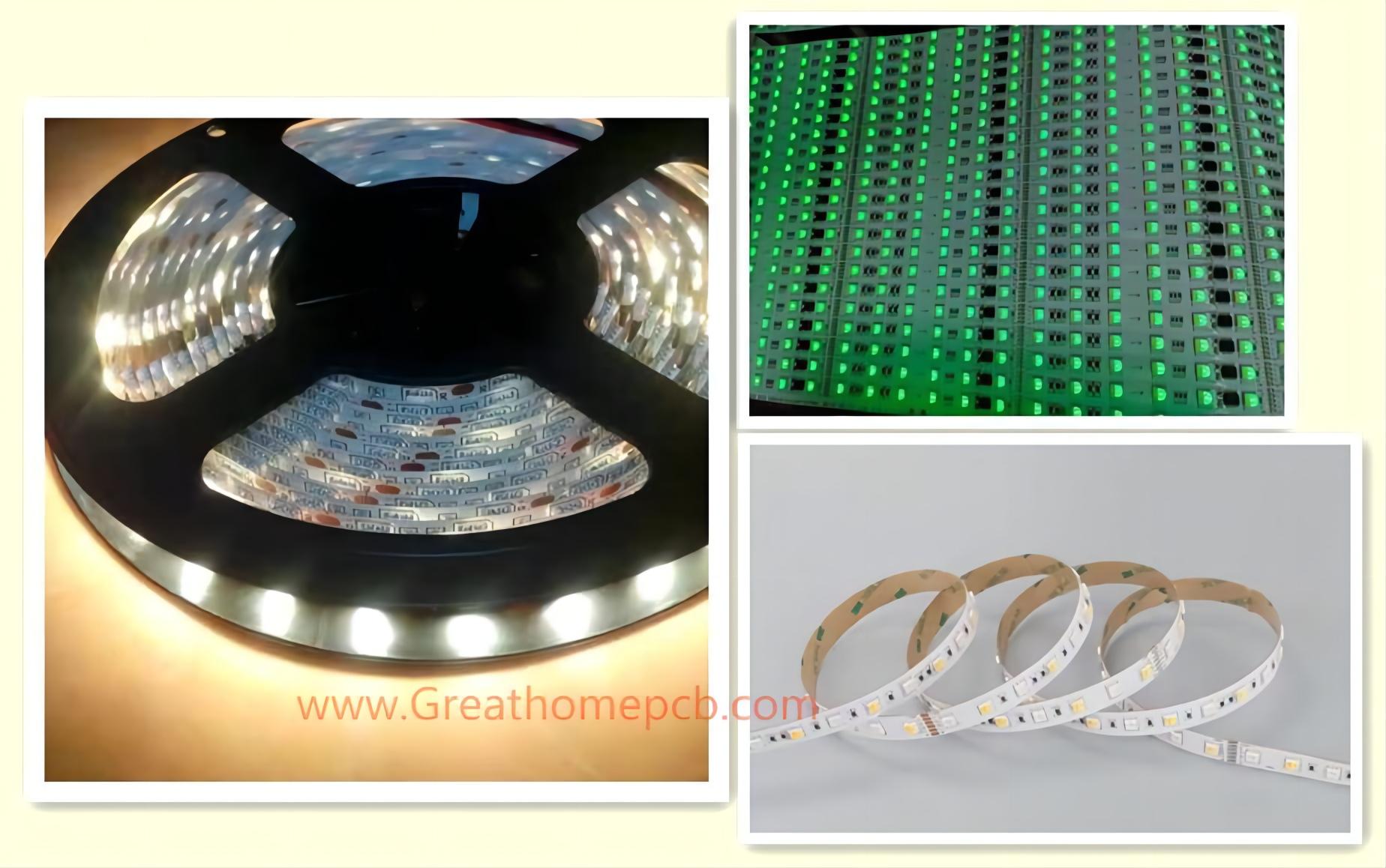
LED strip is usually divided into flexible LED strip and LED Rigid strip.
Flexible LED Strip, also known as LED Light Bar. Flexible LED Strip refers to welding LED lights etc on Strip flexible circuit board with special processing technology such as SMT, and then connecting the power supply to emit light.
Flexible LED strip is made of Flexible Printed Circuit PCB(FPC PCB), LED, Chip resistor, Waterproof silicone, and Connection terminal materials, and the 3M adhesive paper is pasted on the Bottom side for easy installation.
Flexible LED Strip can be cut or extended arbitrarily according to the use needs without affecting the light. FPC PCB material is soft, can be arbitrarily bent, folded, wound, can be moved and expanded in three-dimensional space without breaking. Flexible LED Strip is suitable for use in irregular places and tight Spaces. Due to the flexibility and ultra-thin properties of FPC PCBs (common thickness is 0.15-0.20mm), it has a wider application range.
COB Light Bar(Chips on Board Light Bar) refers to the Flexible Printed Circuit Board on which LED Chips are directly packaged. COB Light Bar is an LED Light Bar that encapsulates LED chips on the Flexible Printed Circuit Board.
Most LED chips are inverted chips, which are placed on the Flexible Printed Circuit board as a linear solid crystal. Then, a layer of packaging glue mixed with fluorescent powder is placed on the surface of the LED chip, and the 3M adhesive paper is pasted on the Bottom side for easy installation. It looks like a strip of ramen stuck to the Flexible Printed Circuit Board. The light emitted by the LED chip in the packaged colloid emits light of different colors and color temperatures evenly through refraction, reflection and interaction with phosphor powder.
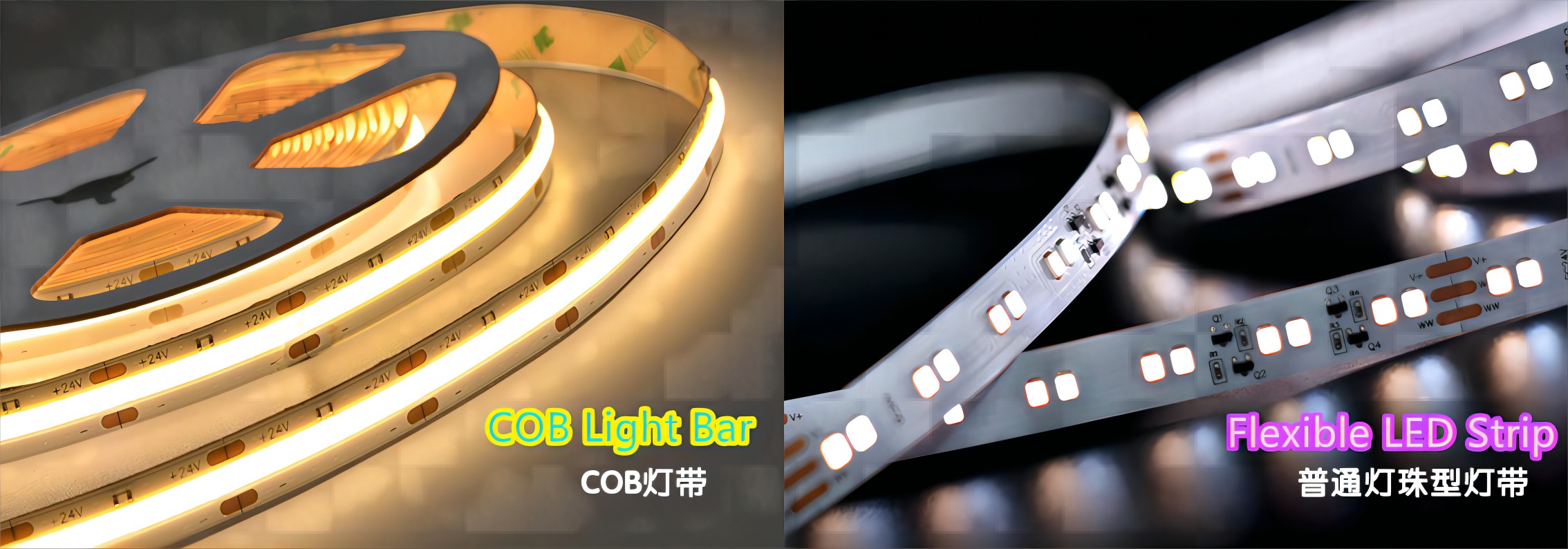
LED Rigid strip, LED Rigid strip refers to welding LED lights etc on Strip Rigid PCB board with processing technology such as SMT, and then connecting the power supply to emit light.
According to different application scenarios, Rigid PCB materials commonly used include FR-4, Aluminum base.
According to the needs of application scenarios, the general thickness of FR-4 or Aluminum base is 0.60mm-1.60mm, and the common thickness is 1.60mm.
LED Rigid strip is made of FR-4 PCB or Aluminum base PCB, LED, Chip resistor and Connection terminal materials.
The advantage of Rigid lamp strip is that it is easy to fix, convenient to process and install. The disadvantage is that it cannot be bent at will and is not suitable for irregular places.

Differences between COB Light Bar and LED Strip:
1. Due to the structural characteristics of COB Light Bar, the luminescent surface is a linear colloid. On the other hand, the common LED strip is made of LED chips, one by one, which are welded to the Flexible Printed Circuit PCB. Therefore, the light emitted by COB light bar is much more uniform and linear without light spot.
2. COB LED chip is directly solidified on the Flexible Printed Circuit PCB, and the heat from the LED chip can be quickly transferred to the Flexible Printed Circuit PCB. Therefore, the chip heat dissipation speed of COB Light Bar is faster than that of LED type LED Strip, and the Light decay of COB Light Bar is smaller and the life is longer.
3. The luminous Angle of the luminous surface of COB Light Bar can reach 180°.

COB Light Bar and Flexible LED Strip main features and advantages:
1. Flexible, can be as curly as wire.
2. It can be arbitrarily cut and extension, does not affect the function.
3. LED and circuit are completely covered in flexible plastic, good insulation, waterproof performance, safe use.
4. Strong weather resistance.
5. Not easy to break, long service life.
6. Easy to make graphics, text and other modeling.
COB Light Bar and Flexible LED Strip application areas:
- Home decoration (stair lighting, hall corridor lighting, lighting decoration, edge hook decoration).
- Path indication and exterior wall outline decoration, backlit billboard lighting, advertising signs, etc.
- All kinds of buildings, commercial buildings, pavilions, Bridges, park squares and other Outlines, building lighting decoration, all kinds of indoor and outdoor lighting projects.
- Festival decoration, activity venue setting, exhibition venue decoration, exhibition hall decoration, showcase, window, props and other applications of decorative lighting.
- Automobile lighting, automobile interior atmosphere decoration.
- Hotel, Bar, KTV, Stage lighting, nightclub and other high-end entertainment venues decoration lighting.


